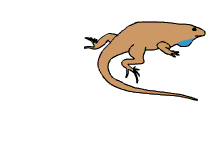
Lizard Pushups: Observer bias
Let's say that you decide to focus on the "function of behavior," and formulate your question as follows:
Q: When a female lizard does pushups in the presence of another female lizard, what benefit does the lizard get from performing this behavior?
How would you go about answering this question? It may seem logical to start with trying to find out if the pushup behavior is a friendly or a hostile signal to the other lizard. However, it is tricky to try to assign value judgments such as "friendly" or "hostile" to the behavior of animals unless you are experienced in observing behavior, and have a lot of background knowledge about the animal you study.
Example: watch the following animation, and decide whether the behavior is "friendly" or "hostile." (Roll mouse over picture to animate. Netscape 4.x: "reload" or click on image to re-run.)
If you are familiar with dogs (and not with cats!), you might be tempted to assume that this is a friendly, "tail-wagging" behavior. You would be dead wrong. Tail-lashing is an aggressive (hostile) signal in many lizards.
How do you avoid wrong interpretations?
